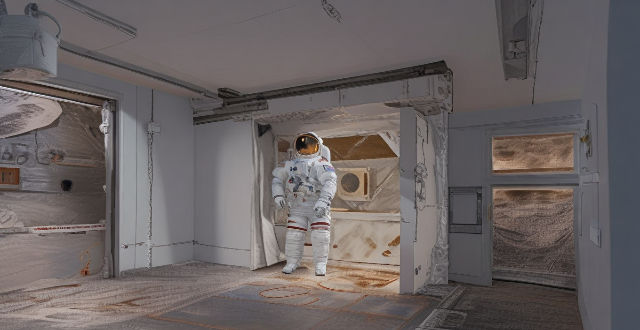Training Mission

How long does it take to train for a space travel mission ?
This article discusses the various aspects of training for a space travel mission, including physical, mental, and technical training. It highlights the duration of each type of training and emphasizes the importance of thorough preparation to ensure the safety and success of the mission.

How can we prevent communication interference during critical missions ?
To prevent communication interference during critical missions, organizations should use reliable communication systems, minimize environmental factors, train personnel adequately, test equipment beforehand, and use clear and concise language. These strategies can help ensure successful completion of missions by minimizing the risk of communication disruptions.

What safety measures are being taken to ensure the success of commercial space missions ?
The topic of this text is safety measures for commercial space missions, which are crucial to ensure the success and well-being of crew members and mission objectives. The key points include redundancy and robustness in system design, thorough testing before launch, comprehensive crew training, emergency procedures, critical onboard systems like life support and communication, and regulatory oversight by agencies like the FAA. In-depth analysis reveals that these measures involve engineering backups for critical systems, simulating space conditions on Earth, preparing astronauts for emergencies, defining clear responses to crises, managing life support and radiation protection, maintaining constant contact with mission control, and adhering to safety standards set by regulatory bodies. As the commercial space industry advances, these safety measures will continue to adapt to new challenges and technologies.

What companies are leading the way in commercial spaceflight ?
Commercial spaceflight is a growing industry with several key players, including SpaceX, Blue Origin, Virgin Galactic, Boeing, and Rocket Lab. Each company has its own mission and achievements, ranging from successful launches and landings of rockets to developing new spacecraft for future missions. These companies are leading the way in advancing humanity's exploration and utilization of space.

How much does it cost to travel to space ?
The cost of traveling to space varies depending on the type of mission, duration of stay, and provider. Suborbital flights are the most affordable option, while lunar and Mars missions are significantly more expensive. Factors such as training, technology, and risk contribute to the high costs. As technology advances and more companies enter the industry, the cost may decrease, but space travel is unlikely to become affordable for the average person in the near future.

What are the challenges faced by astronauts during long-duration space missions ?
Long-duration space missions pose physical, psychologicalLong-duration space missions pose physical, psychological astronauts, including including muscle atrophy, bone loss, radiation exposure, immune system changes, isolation, communication delays, sleep disturbances, resource management, equipment maintenance, and task scheduling. Addressing these challenges is crucial for the success of future deep space exploration efforts.

What are some successful women-led philanthropic projects that have made a significant impact in their communities ?
The article discusses several successful women-led philanthropic projects that have made significant impacts in their respective fields. These include The Malala Fund, which aims to empower girls' education globally; The Empowerment Center for Women in Saudi Arabia, which provides skills training and job opportunities for women; The Global Fund for Women, which supports grassroots women's groups worldwide; The Akilah Institute, which offers quality education and leadership training to young women in Zimbabwe; and The Women's Refugee Commission, which advocates for the protection of refugee women and children.

Why is critical thinking training important ?
In today's complex world, critical thinking training is essential for effective problem-solving, communication, objectivity, creativity, and future preparedness. It enhances decision-making, collaboration, fairness, open-mindedness, and adaptability to changes. Investing in this training leads to success and positive impacts in various domains.

What are the best training methods for a marathon ?
The article provides a summary of the best training methods for a marathon, including long runs, interval training, hill training, tempo runs, cross-training, recovery weeks, race pace workouts, and tapering. It emphasizes the importance of consistency, patience, and listening to one's body during training.

How do I manage stress while training for a marathon ?
Managing stress is crucial during marathon training. Tips include setting realistic goals, following a structured plan, prioritizing recovery, staying hydrated and nourished, getting enough sleep, practicing mindfulness, seeking support, managing time wisely, and embracing the process. These strategies help minimize stress and make the training journey more enjoyable.

How often should I attend a tennis training camp to improve my game significantly ?
How often you should attend a tennis training camp to improve significantly depends on your current level and experience, goals, quality of training, personal commitments, physical recovery needs, and budget. Finding a balance that works for you is key to maximizing your chances of improvement.

How do online teacher training courses compare to traditional in-person workshops ?
This text compares online teacher training courses with traditional in-person workshops in terms of flexibility, interactivity, cost-effectiveness, personalization, networking opportunities, practice and application, technology requirements, certification, scalability, and updates. It concludes that both have unique advantages and limitations, and the choice often depends on individual preferences and the specific goals of the training.

How do I prevent injuries during marathon training ?
Preventing injuries during marathon training is crucial for a successful and enjoyable race. To reduce the risk of injury, runners should warm up and cool down properly, gradually increase training intensity, incorporate cross-training, wear proper footwear, stay hydrated and well-nourished, schedule rest days, listen to their bodies, engage in strength training and flexibility work, and prepare for race day with pacing strategies and course familiarization. By following these guidelines, runners can minimize the chances of getting injured and maximize their potential for success on race day.

Can strength training help with weight loss ?
Strength training, involving the use of resistance to induce muscular contraction and build strength, can significantly contribute to weight loss by increasing metabolic rate, boosting post-exercise oxygen consumption (EPOC), improving body composition, and enhancing appetite control. Incorporating strength training into your routine, starting slowly and focusing on compound movements while staying consistent, can help achieve weight loss goals.

How do I know if a tennis training camp offers quality coaching ?
When considering enrollment in a tennis training camp, it is crucial to assess the quality of coaching by examining credentials and experience of coaches, coach-to-player ratios, training methods and philosophy, reputation and reviews, facilities and support services, and personalized attention and feedback.

How do military strategies need to adapt to address the consequences of climate change ?
The text discusses the challenges and adaptations necessary for military strategies to account for the consequences of climate change. It emphasizes the need for impact assessments, operational planning, training and preparation, technology and innovation, cooperation and diplomacy, and readiness and response. Key points include understanding how climate change affects specific regions, developing resilient supply chains and adaptive infrastructure, incorporating climate change into training scenarios, utilizing advanced predictive tools, working with allies and international organizations, and establishing rapid response capabilities. By integrating these elements into defense policy, militaries can remain effective and resilient in the face of a changing climate.

What is the balance between specialized training and cross-training for optimal sports performance ?
In the realm of sports performance, achieving a balance between specialized training and cross-training is crucial for athletes to reach their peak potential. Specialized training focuses on improving skills, techniques, and strategies specific to an athlete's chosen sport, while cross-training involves engaging in other forms of exercise or activities that complement and enhance overall fitness and athleticism. This article explores the importance of finding the right balance between these two approaches and how it can lead to optimal sports performance. Specialized training helps athletes develop sport-specific skills, fitness, and mental preparation, while cross-training promotes injury prevention, overall fitness, and mental health. Achieving the right balance depends on various factors such as an athlete's goals, age, experience level, and individual needs. Tips for finding the right balance include assessing goals, consulting with professionals, monitoring your body, incorporating variety, and staying motivated. By finding the right balance between specialized training and cross-training, athletes can optimize their sports performance while minimizing the risk of injury and maintaining overall health and well-being.

What is critical thinking training ?
This article provides an in-depth analysis of critical thinking training, explaining what it is and why it's important. It lists several benefits of critical thinking, such as enhanced problem-solving skills, improved decision making, boosted communication abilities, and increased adaptability. The article also offers strategies for developing critical thinking skills, such as asking questions, challenging assumptions, considering multiple perspectives, evaluating evidence, avoiding bias, practicing reflective thinking, learning from mistakes, engaging in dialogue, reading widely, and seeking feedback. Overall, the article emphasizes the importance of critical thinking training for personal and professional development.

What kind of physical conditioning is included in a tennis training camp program ?
Tennis training camps typically include exercises to improve cardiovascular endurance, strength, agility, and flexibility.

How can personal safety training help prevent sexual harassment and violence in the workplace ?
Personal safety training is crucial for preventing sexual harassment and violence in the workplace. It educates employees on recognizing inappropriate behaviors, understanding reporting procedures, implementing prevention strategies, building awareness, and creating a supportive culture. This training empowers individuals to maintain a safe work environment and fosters a culture of respect and professionalism.

Is strength training safe for beginners ?
Strength training is a form of exercise that can provide numerous benefits, including increased muscle mass and strength, improved bone density, better body composition, reduced risk of injury, and enhanced athletic performance. However, it is essential to take safety measures to prevent injuries from improper technique or overexertion. Before starting any new exercise program, consult with a healthcare professional to ensure that you are healthy enough to participate. Start slowly and gradually increase intensity, focus on proper technique, warm up and cool down properly, and listen to your body. By following these tips, beginners can safely start strength training and enjoy its many benefits while minimizing the risk of injury.

How do international teacher training standards compare across different countries ?
This text is about the differences in teacher training standards across countries. It explains that while there are some common elements to most teacher training programs, such as foundational education and practical experience, there are also significant differences due to factors like cultural influences and funding. The text then goes on to describe these differences in more detail.

Can virtual reality training improve athlete skills ?
Virtual reality (VR) technology has been increasingly utilized in sports training, raising the question of whether it can improve athlete skills. The answer depends on several factors, including the type of sport and specific skills required. VR platforms offer a novel medium to develop cognitive skills such as concentration and alternating attention. They can be highly beneficial for sports requiring precision and accuracy, providing a controlled environment for repeated practice and immediate feedback. However, VR should not replace traditional physical training entirely but be used as a supplementary tool. Additionally, VR can help athletes mentally prepare for competition by simulating game scenarios and practicing decision-making skills under pressure. The effectiveness of VR training depends on various factors, and its evolution in sports training programs will be interesting to observe as technology advances.

Can strength training be part of a female fitness program ?
**Can Strength Training Be Part of a Female Fitness Program?** Yes, strength training is crucial for women's fitness programs. It offers benefits such as improved muscle tone, increased metabolism, enhanced bone density, and reduced injury risk. To integrate strength training effectively: start with light weights, focus on compound movements, balance it with cardio workouts, and consider professional guidance for personalized plans. This approach ensures a comprehensive and beneficial fitness regimen for women.

Can strength training help improve my running performance ?
Strength training is an essential component of any fitness program, including running. It helps to build muscle strength and endurance, which can significantly improve your running performance. Strength training can help increase muscle strength and endurance, improve running economy, reduce the risk of injury, and enhance posture and body alignment. To incorporate strength training into your running routine, start slowly with light weights and gradually increase intensity over time. Choose exercises that target major muscle groups used during running, such as glutes, hamstrings, quadriceps, calves, and core muscles. Incorporate plyometric exercises to improve explosive power and acceleration. Allow sufficient recovery time between sessions to avoid overtraining and potential injuries.

What are the physiological benefits of resistance training ?
Resistance training offers numerous physiological benefits, includingResistance training offers numerous physiological benefits, includingurance, improved bone density It is an essential part of any fitness routine for achieving optimal health and wellness outcomes.

What are the benefits of critical thinking training ?
Critical thinking training offers numerous benefits, including improved decision-making skills, enhanced problem-solving abilities, increased self-awareness, improved communication skills, and boosted creativity. By learning how to analyze information and evaluate evidence in a clear, rational, and objective manner, individuals can make more informed decisions, find creative solutions to difficult challenges, build stronger relationships, and generate new ideas. Overall, critical thinking training can help individuals succeed in both personal and professional settings and reach their full potential.

What benefits do sports-specific training programs offer ?
Sports-specific training programs offer several benefits, including improved performance, increased physical fitness, enhanced mental toughness, better recovery and injury prevention, and personalized coaching and support. These programs focus on developing the skills, techniques, and physical abilities required for success in a particular sport, helping athletes reach their full potential while also improving their overall health and well-being.

What are the safety measures taken for space tourism ?
Space tourism requires rigorous safety measures, including physical trainingSpace tourism requires rigorous safety measures, including physical trainingancy, medical screenings, including physical training, spacecraft redundancy, medical screenings, and reliable communication systems.

What is the daily schedule like at a typical tennis training camp ?
A tennis training camp's daily schedule focuses on skill enhancement, fitness, and mental preparation through activities like morning practice, theory sessions, match play, and fitness training. The day starts early with wake-up calls around 6:00 AM and ends with an early bedtime to ensure rest for the next day's intensive training. Leisure activities are included to promote relaxation and social interaction among participants.